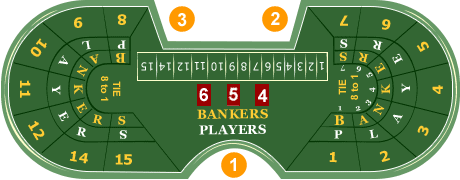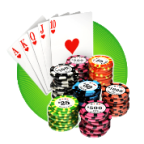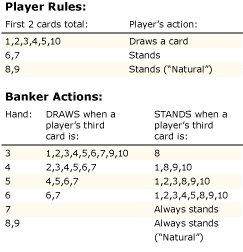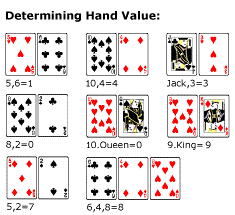 |
BACCARAT Baccarat is a card game, played at casinos. It is believed to have been introduced into France from Italy during the reign of King Charles VIII, and it is similar to Faro and Basset. There are three popular variants of the game: punto banco, baccarat chemin de fer, and baccarat banque. Baccarat means “zero” and that is exactly what you do not want in this game. The winner of Baccarat is the player that holds cards totaling 9 or the closest to 9. In order to count your cards in Baccarat you will total the cards then drop the “tens” digit. |
Accessoiries
| The Table: Areas on the Baccarat Table:
|
 |
The layout of the table is quite simple. The table consists of player seating positions that are marked by numbers, from 1 to 15.
That means, maximum 14 players can play on one table (number 13 is eliminated due to superstitious beliefs about 13).
| The Deck of Cards: You will need 8 decks of cards for playing Baccarat. For different variation of the game there are different numbers of the decks. For example in Punto Banco the number of decks of cards may be 4, 6 or 8. |
 |
| The Chips: by the late 1800s, there were finally clay baccarat chips being made. As technology improved and new materials and production methods began appearing, plastic chips and acrylic chips also started to be made. Other materials include ivory and composites of stones and other materials. By the middle of the 20th century, the massive casinos that have come to be the preferred destination for gamblers around the globe began to popularize. First, there was a need to start producing literally millions of baccarat chips. Secondly, there was a need to be able to separate and authenticate the multitudes of baccarat chips on the market. With today's technology, that means that baccarat chips used by casinos have microchips implanted in them, weigh very specific amounts and come with different sizes and textures. |
 |
Banker and Player Roles
The Banker is a player who puts his money up for the “Player” to bet against. You may not be a Banker and Player at the same time.
The Player’s “hand” may be played by 5 to 12 players. In order for this to work, there are a set of quite formal rules on how play will
proceed. The dealer deals the Banker and the Player two face-down cards. That is two cards for the Banker and two cards total for all
players that represent the “Player”. Players may bet on the Banker, the Player, or a third spot on the table marked “Egalite”, or “Tie”
in French.
Anyone sitting around the game can see each card that passes out of the shoe. In this, a card-counter may be born. To count cards
in a shoe with 6 to 8 decks in itself is a task and will require that you choose a tracking system.
|
Player’s Third Card Rules
After the dealer has dealt the two face-down cards to the Player and Banker, you must learn the rules that dictate if you are allowed
to take a third card. The Player rules on the third card are quite straightforward.Player on the Third Card - If your first two cards total a 0-5, draw a third card. If your first two cards total 6 or 7, then you stand. Banker’s Third Card Rules
If the Player did draw a third card, then the Banker follows these rules: • If the Player's third card is a 2 or 3, the Banker will draw if he has a 0-4 and stays with a 5-7. • If the Player's third card is a 4 or 5, the Banker will draw if he has a 0-5 and stays with a 6-7. • If the Player's third card is a 6 or 7, the Banker will draw if he has a 0-6 and stays with a 7. • If the Player's third card is an 8, the Banker will draw if he has a 0-2 and stays with a 3-7. If the Player's third card is a 9, 10, face card or Ace, the Banker will draw if he has a 0-3 and stays with a 4-7. If the Player did not draw a third card, then the Banker follows the same rules just mentioned above. |
 |
Cards and Values |
 |
Varieties of Baccarat
-
PUNTO BANCO or NORTON AMERICAN BACCARATIn Punto Banco the Banker role does not rotate. In fact, the casino will bank the game and the position on Banker is only ceremony in this game. Players are allowed to place their wagers on with the Player /Punto/ or the Banker - Banco. This version is super quick and easy to learn and there is no skill needed to master it.
-
CHEMIN DE FER or RAILWAYThis is The French version ot Baccarat games and is the favorite in Europe. This game has the Banker place his own personal money at stake for the game. The Banker may take or lose all that is staked. The house takes only a 5% rake for their services. The rules that dictate the Banker’s third card rules are more flexible since it is the Banker’s money at stake.
-
A DEUX TABLEAU“Two Tables” are what makes this version unique. There is still a Banker and Player, but there are two hands played to the Player. The people playing may bet on one or both of the Player cards, but not on the Banker. The Banker is another player that has staked their own money.